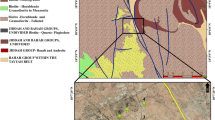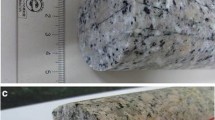Abstract
A hydrogeologic characterization and impact analysis was performed for a proposed quarry at the Hitch Rack Ranch located in the Little Turkey Creek watershed southwest of Colorado Springs, Colorado. Continuous multiple channel tubing, nested piezometers, stream flow measurements, and mapping of known seeps were used to define the three-dimensional potentiometric distribution and areas of groundwater recharge and discharge. Water balance considerations, mass balance calculations, and potentiometric response to earth tides and barometric fluctuations confirmed that the granite fracture system in the ridge area of the proposed quarry has an extremely low bulk hydraulic conductivity resulting in minimal groundwater discharge to sustain the baseflow of Little Turkey Creek. The Little Turkey Creek valley forms the major conduit for groundwater flow exiting from the upper part of watershed underlain by granite. This conclusion has significant implications with respect to mine planning to minimize projected impacts to the hydrologic system and preserve this recharge component to downgradient Denver Basin sedimentary deposits.













Similar content being viewed by others
References
Long JCS, Remer JS, Wilson CR, Witherspoon PA (1982) Porous media equivalents for networks of discontinuous fractures. Water Resour Res 18(3):645–658
Bossong CR, Caine JS, Stannard DI, Flynn JL, Stevens MR, Heiny-Dash JS (2003) Hydrologic conditions and assessment of water resources in the Turkey Creek watershed, Jefferson County, Colorado, 1998-2001. Water-Resour Investigs Rep 2003–4034(140):45 figs. https://pubs.usgs.gov/wri/wri03-4034/. Accessed 2/10/2019
Wilson JL, Guan H (2004) Mountain-block hydrology and mountain-front recharge. In: Phillips FN, Hogan J, Scanlon B (eds) Groundwater Recharge in A Desert Environment: The Southwestern United States. American Geophysical Union, Washington https://www.rosemonteis.us/sites/default/files/references/wilson-guan-2004.pdf. Accessed 2/11/2019
Nesse WD (2006) Geometry and tectonics of the Laramide Front Range, Colorado: the rocky mountain association of geologists. Mountain Geol 43(1):25–44
Trimble DE and Machette MN (1979) Geologic map of the Colorado Springs-Castle Rock Area, Front Range Urban Corridor, Colorado: U.S. Geological Survey Miscellaneous Investigations Series Map I–857-F, scale 1:100,000
U.S. Geological Survey (2018). The National map. U.S. Department of Interior, U.S. Geological Survey, National Geospatial Program. https://viewer.nationalmap.gov/advanced-viewer/. Accessed Feb 2018
Colorado Division of Water Resources – Well Permit database. https://dwr.state.co.us/Tools/WellPermits. Accessed Sept 2017
Western regional climate center (2019) period of record monthly climate summary. Desert Research Institute, Western Regional Climate Center. Reno, Nevada. www.wrcc.dri.edu. Accessed Mar 2019
US. Geological Survey (2018). National water information system. U.S. Department of Interior, U.S. Geological Survey, National Geospatial Program. https://waterdata.usgs.gov/nwis. Accessed Mar 2019
Solinst Canada Ltd, Product Information. https://www.solinst.com/products/multilevel-systems-and-remediation/cmt-multilevel-system.php. Accessed Apr 2017
Cutillo PA, Bredehoeft JD (2011) Estimating aquifer properties from the water level response to earth tides. Ground Water 49(4):600–610
Allegre V, Brodsky EE, Xue L, Nale SM, Parker BL, Cherry JA (2016) Using earth-tide induced water pressure changes to measure in situ permeability: a comparison with long-term pumping tests. Water Resour Res 52:3113–3126. https://doi.org/10.1002/2015WR017346
Freeze RA, Cherry JA (1979) Groundwater. Prentice Hall, Inc., Engelewood Cliffs
Bense VF, Gleeson T, Loveless SE, Bour O, Sconek J (2013) Fault zone hydrogeology. Earth Sci Rev 124:171–192
Marler J, Ge S (2003) The permeability of the Elkhorn Fault Zone, South Park, Colorado. Ground Water 41(3):321–332
Caine JS, Evans JE, Forster CB (1996) Fault zone architecture and permeability structure. Geology 18:1025–1028
Jacob CE (1940) On the flow of water in an elastic artesian aquifer. Trans Am Geophys Union 21:574–586
Todd DK (1980) Groundwater hydrology, 2nd edn. John Wiley & Sons, New York
Harbaugh AW, Banta ER, Hill MC, McDonald MG (2000) MODFLOW-2000, the U.S. geological survey modular ground-water model—user guide to modularization concepts and the groundwater flow process: U.S. Geol Survey Open-File Rep 2000–92:121
Acknowledgments
The authors acknowledge Transit Mix Concrete Co. for funding the work that provided the basis for this manuscript.
Author information
Authors and Affiliations
Corresponding author
Ethics declarations
Conflict of Interest
The work that provided the basis for this manuscript was performed while the authors were providing consulting services to Transit Mix Concrete Co.
Additional information
Publisher’s Note
Springer Nature remains neutral with regard to jurisdictional claims in published maps and institutional affiliations.
Rights and permissions
About this article
Cite this article
Day, M., Kos, P. & Brinton, S. Hydrogeologic Characterization and Mining Impact Analysis of a Low-Yield, Fractured Granite. Mining, Metallurgy & Exploration 37, 355–374 (2020). https://doi.org/10.1007/s42461-019-00172-x
Received:
Accepted:
Published:
Issue Date:
DOI: https://doi.org/10.1007/s42461-019-00172-x




